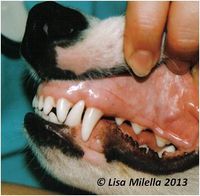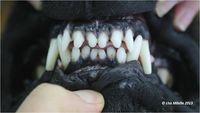Dental Malocclusion
Introduction
By definition, malocclusion is an abnormality in the position of the teeth. The clinical significance of malocclusion is that it may cause discomfort and sometimes pain to the affected animal. In some cases, it may be the direct cause of severe oral pathology.
Normal Occlusion
The ideal occlusion can be described as the perfect interdigitation of the upper and lower teeth. In the normal dog, the ideal tooth positions in the arches are defined by the occlusal, inter-arch and interdental relationships of the teeth.
The ideal relationship with the mouth closed can be defined by the following:
- Maxillary incisor teeth all positioned rostral to the corresponding mandibular incisor teeth.
- Mandibular canine tooth is inclined labially and bisects the interproximal space between the opposing maxillary third incisor tooth and canine tooth.
- Maxillary premolar teeth do not contact the mandibular premolar teeth.
- The mesial crown cusp of the maxillary fourth premolar tooth is positioned lateral to the space between the mandibular fourth premolar tooth and the mandibular first molar tooth.
This is described as orthoclusion.
The length of a dog's jaw is most importantly determined by its genetic background. Problems exist commonly in dogs mainly due to the great variation in skull types within the species. Other factors can influence jaw length during growth, such as diet, metabolism, trauma, infection and forces within the mouth.
Signalment
With the mesocephalic skull shape, the mandible is shorter and less wide than the upper jaw. Dolicocephalic breeds have a longer than normal upper jaw. The increased jaw length results in interdental spaces that are wider than normal. Brachycephalic animals have a shorter than normal upper jaw. A short jaw results in reduced interdental spaces with rotation and/or overlap of teeth.
Malocclusion is common in the dog, but also occurs in cats.
Malocclusion Types
Malocclusion can result from jaw length and/or width discrepancy (skeletal malocclusion), from tooth malpositioning (dental malocclusion), or a combination of both. The development of the occlusion is determined by both genetic and environmental factors. Specific genetic mechanisms regulating malocclusion are unknown. A polygenic mechanism, however, is likely and explains why not all siblings in successive generations are affected by malocclusion to the same degree, if at all. With a polygenic mechanism, the severity of clinical signs is linked to the number of defective genes. The most reasonable approach to evaluate whether malocclusion is hereditary or acquired is as follows:
- Skeletal malocclusion is considered inherited unless a developmental cause can be reliably identified.
- Pure dental malocclusion, unless known to have breed or family predisposition, should be given the benefit of the doubt and may not necessarily be considered inherited.
An outline of the more common types of malocclusion is given below.
Skeletal Malocclusion
Mandibular prognathic bite: In the mandibular prognathic bite (pic4 malocclusion), often called ‘undershot’, the mandible is longer than the maxilla and some or all of the mandibular teeth are rostral to their normal position. If the dental interlock prevents the mandible from growing rostrally to its genetic potential, lateral or ventral bowing of the mandible may occur to accommodate the length. This results in an open bite and is characterized by increased space between the premolar cusp tips. In addition, the caudal angle of the mandible is caudal to the temporomandibular joint to accommodate the extra length of the mandible.
Mandibular brachygnathic bite: A mandibular brachygnathic bite, often called ‘overshot’, occurs when the mandible is shorter than normal. This will often result in the mandibular canine contacting the palate, causing trauma. (pic 5malocclusion)
Wry bite: A wry bite occurs if one side of the head grows more than the other side. In its mildest form a one-sided prognathic or brachygnathic bite develops. In more severe cases, a crooked head and bite develop with a deviated midline. An open bite may also develop in the incisor region so that the affected teeth are displaced vertically and do not occlude. (pic6 malocclusion)
Narrow mandible: In some animals, the mandible is too narrow with respect to the upper jaw. The result is that the lower canines impinge on the maxillary gingivae or the hard palate instead of fitting into the diastema between the upper third incisor and upper canine on either side. The animal may not be able to close its mouth and injury to the gingivae or palatal mucosa commonly occurs. In untreated severe cases, an oronasal communication may develop over time. This condition is seen in both the primary (deciduous) and permanent dentition. Persistent mandibular primary canines will further exacerbate the condition, as the permanent mandibular canines erupt medially to their primary counterparts. The incorrect dental interlock will interfere with the normal growth in width and length of the developing mandible. The condition can also be caused by persistent primary mandibular canines in a mandible of normal width. (pic 7 malocclusion)
Dental Malocclusion
Dental malocclusion is malpositioning of teeth where there is no obvious skeletal abnormality, i.e. there is no jaw length or width discrepancy.
Anterior crossbite: This is a clinical term used to describe a reverse scissor occlusion of one, several or all of the incisors. The condition can be secondary to persistent primary incisors. However, there is probably a skeletal origin as well, since affected animals often develop a mandibular prognathic bite. In other words, an anterior crossbite in an immature animal may be the first sign of a developing mandibular prognathism. The cause can be either a dental malocclusion (i.e. linguoversion of the upper incisors) or a skeletal malocclusion (i.e. mandibular prognathism or maxillary brachygnathism). Pic8 malocclusion
Malocclusion of the canine teeth: The two most common abnormalities in canine tooth position are:
- Rostral displacement (mesioversion) of the maxillary canines. Persistent primary canines may be responsible for this condition. A breed predisposition has been reported in the Shetland sheepdog. (pic9malocclusion)
- Medial displacement of the lower canines. (pic10mal)
Malocclusion of the premolars and molars: Posterior crossbite is used to describe an abnormal relationship of the carnassial teeth, seen commonly in the dolicocephalic breeds, where the normal buccolingual relationship is reversed.
Classification of Malocclusion
Class 1 malocclusion
Also called neutroclusion, this describes a normal rostral-caudal relationship of the maxillary and mandibular dental arches but there is malposition of one or more individual teeth.
Class 2 malocclusion
This is also called mandibular distoclusion, mandibular brachygnathism or mandibular retrognathism.
In layman's terms this is referred to as an overshot jaw or a parrot mouth.
This describes an abnormal rostral-caudal relationship between the dental arches in which the mandibular arch occludes caudal to its normal position relative to the maxillary arch.
Breeds commonly affected include the Rough Collie and the Borzoi.
Class 3 malocclusion
This is also called mandibular mesioclusion, mandibular prognathism.
In layman's terms this is referred to as an undershot jaw.
This describes an abnormal rostral-caudal relationship between the dental arches in which the mandibular arch occludes rostral to its position relative to the maxillary arch.
One of the breeds most commonly affected is the Boxer.
Clinical Importance of Malocclusion
Even an otherwise sound, well cared-for dentition may show asymmetric abrasion or attrition.
Problems may occur with mastication and temporomandibular joint function.
Soft tissue trauma is a common sequel of malpositioned teeth.
Premature loss of teeth may be caused by an increased liability to periodontitis.
Owners should also be counselled with regards the possible inheritance of the condition. Dogs with severe dental malocclusion should not be bred from.
Treatment
The primary aim is to relieve pain and discomfort.
Dental extraction is usually the most rapid method of relieving pain and treating any soft tissue injuries such as palatal trauma from canines. In growing animals, teeth should be exctracted preferably before 12 weeks of age, with great care taken not to damage the developing permanent teeth. Extraction should be performed bilaterally symmetrically to prevent any influence of growth of the jaws.
If dental malocclusions are relieved early, this will provide the jaws with the maximum time to achieve full growth.
Antibiotics may be required if secondary infection is present.
| Dental Malocclusion Learning Resources | |
|---|---|
 Test your knowledge using flashcard type questions |
Veterinary Dentistry Q&A 09 |
References
Johnson, N. (2009) Dentistry 1 RVC student notes
Verstraete, F. (1999) Self-assessment colour review of veterinary dentistry Manson Publishing
| This article has been peer reviewed but is awaiting expert review. If you would like to help with this, please see more information about expert reviewing. |
Error in widget FBRecommend: unable to write file /var/www/wikivet.net/extensions/Widgets/compiled_templates/wrt6635e9c3ad4b68_07348966 Error in widget google+: unable to write file /var/www/wikivet.net/extensions/Widgets/compiled_templates/wrt6635e9c3b09234_84416980 Error in widget TwitterTweet: unable to write file /var/www/wikivet.net/extensions/Widgets/compiled_templates/wrt6635e9c3b38666_01936421
|
| WikiVet® Introduction - Help WikiVet - Report a Problem |

